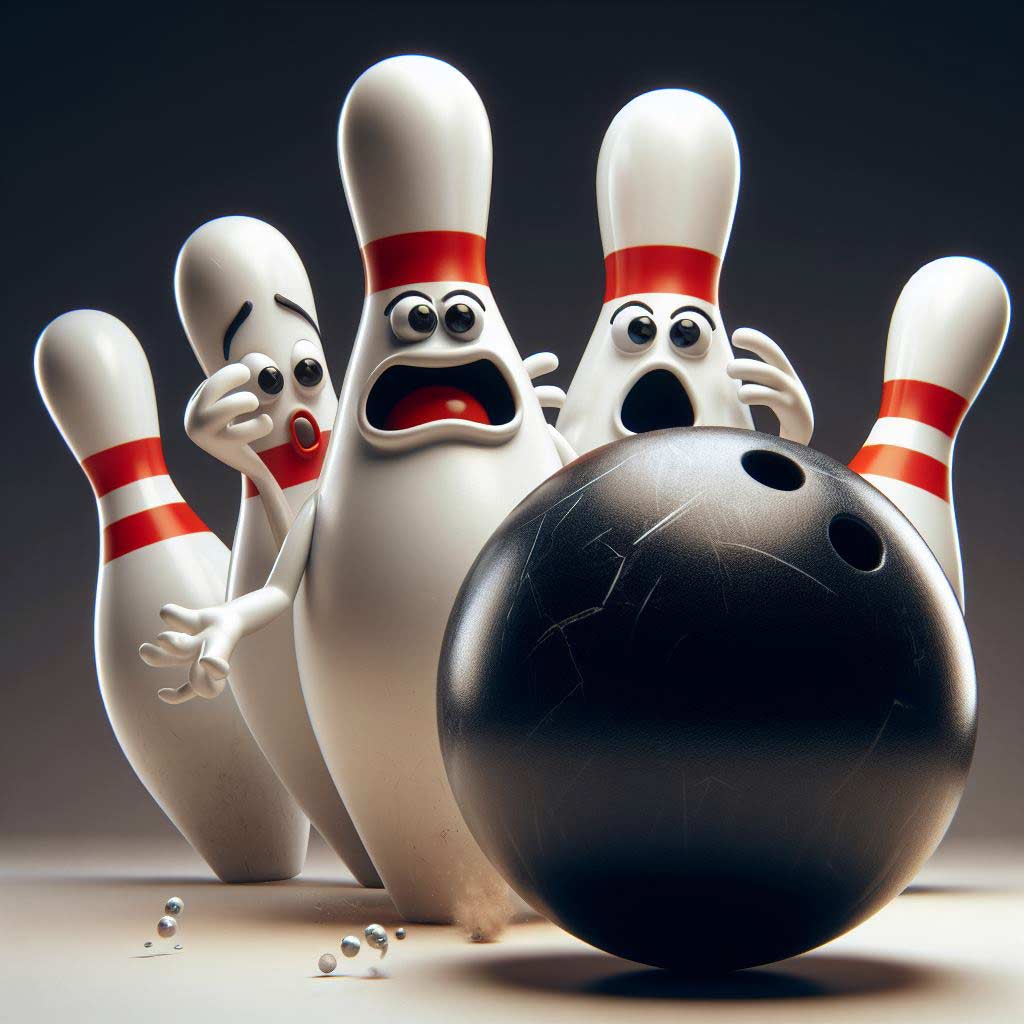Bowling is one of America’s most beloved pastimes, with over 70 million people heading to the lanes every year. But for new bowlers learning the intricacies of scoring can be confusing at first. With different markings, strikes, spares, and even specialized scoring systems, there’s a lot to take in.
That’s why we’ve created this comprehensive guide to bowling scoring. Whether you’re a beginner picking up a ball for the first time or a seasoned league bowler brushing up on your skills, this article will walk you through everything you need to know.
We’ll cover the basics of how scoring works, the methods for recording strikes and spares, general scoring concepts, advanced rules, how to calculate game totals, and various bowling score variations. With this guide, you’ll be scoring like a pro in no time. So grab your bowling shoes, ball, and score sheet – let’s get rolling!
Scoring Basics – How Bowling Scoring Works
The basics of scoring in bowling are relatively simple once you understand the foundation. Here are the key things to know:
- Bowling is played by rolling a ball down a wooden or synthetic lane to knock down as many pins as possible.
- There are 10 pins set up at the end of the lane in a triangle formation.
- The game is played in 10 frames, allowing the bowler 2 chances each frame to knock down all 10 pins.
- The score is the number of pins knocked down, plus bonus points for strikes and spares.
- A game is finished when all 10 frames have been completed.
- The max score possible is 300, achieved by bowling 12 strikes in a row.
So in a nutshell, knock down pins to score points frame by frame. Now let’s get into the fun part – how to record strikes, spares, and other shots on your bowling score sheet.
How to Score Strikes
A strike is the best shot in bowling, and also the easiest to score. Here are the rules on strikes:
- A strike is when you knock down all 10 pins on the first roll in a frame.
- To record a strike, you mark an “X” in the small first box for that frame.
- A strike earns 10 points for the pins, plus bonus points for the next two rolls.
- For the two rolls after a strike, you add those points to the strike’s 10.
For example, if you roll a strike in frame 1, and then get 7 pins / 3 pins in frame 2, your score for frame 1 would be 10 (for the strike) + 7 + 3 = 20 points. Three rolls, 20 points total.
This double scoring for strikes is what allows bowlers to achieve those high scores over 200. Strikes are the goal!
How to Score Spares
A spare is the second-best shot in bowling after a strike. Here is how spares work for scoring:
- A spare is knocking down all 10 pins between your two rolls in a frame.
- To record a spare, mark a “/” in the second small box for that frame.
- A spare earns 10 points for the pins, plus a bonus just for the next roll.
- For the first roll after a spare, add those points to the frame’s 10 points.
For example, if you knock down 7 pins on the first roll in frame 3, then pick up the spare, you would record that as 7/ in frame 3. If you then got 5 pins on the first roll in frame 4, your score for frame 3 would be 10 (for the spare) + 5 (the next roll) = 15 points.
Scoring spares helps bowlers make up for 0’s and low counts on open frames. Anytime you convert a spare, celebrate!
Other Basic Bowling Scoring Concepts
Beyond strikes and spares, there are some other core scoring concepts good bowlers should know:
Open Frames
- An open frame means you did not strike or spare in that frame.
- Record the number of pins knocked down for each roll in the two boxes.
- There is no bonus – you only get credit for pins knocked down.
Split Conversions
- When you convert a tough split by getting two pins from different groups, that still counts as a spare if you get 10 pins across both rolls. Mark it just like a regular spare.
Gutter Balls
- A gutter ball (0 pins down) is marked with a “-” dash in the box.
- Two dashes in one frame mean an open with 0 points.
Extra Frames
- If the game ends in a tie, extra frames can be played until the tie is broken.
- Fill out extra frames on the back of the score sheet.
Team Scoring
- In team play, scores combine across all teammates bowling in a frame to get a team total.
- Fill out the team score boxes at the bottom to get a grand total.
Advanced Bowling Scoring Rules
Once you’ve mastered the basics, here are some more advanced scoring rules you may encounter:
Fouls
- Touching or going over the foul line results in a foul.
- For a foul on the first roll, count pins knocked down but mark an “F”.
- For a foul on the second roll when the first was a strike, score the frame as a strike.
Pin Fall
- If a pin falls even after the bowler’s turn, it still counts (called pin fall).
- Unless it was clearly after the next bowl – that’s considered the next player’s pins.
Dead Balls
- If a ball gets stuck on the lane or the bowler resets pins incorrectly, the shot is declared dead.
- Gets to re-bowl that shot when declared dead. No points on dead balls.
Score Sheet Markings
Keeping an accurate score sheet is a key bowling skill. Here are the typical markings:
- “X” – Strike
- “/” – Spare
- “-” – Miss or gutter ball
- “F” – Foul
Also fill out names, dates, game numbers, frame-by-frame points, and total score. Take your time and double-check – accuracy matters!
Calculating Game Totals and Scores for Each Frame
With the basics of strikes, spares, and open frames, you can calculate totals by:
- Adding up points from strikes and spares and any related bonus rolls.
- Adding the number of pins knocked down for each roll on open frames.
- Double-check your score sheet subtotals for each frame.
- Adding up all 10 frames at the end for your total score.
Apps and automatic scorers make this easy. But it’s good to understand how to arrive at totals manually too.
Take your time, fill out the score sheet neatly, take bonus rolls into account, and calculate the running total as you go. Mark your score clearly in the end – do a double-check that it looks right.
Bowling Score Variations
Beyond traditional scoring, there are some variations you may encounter:
No-Tap Scoring
- Any pins knocked down on the first ball are counted as a strike.
- Used in more casual games to increase scoring.
3-6-9 Scoring
- Knocking down 3, 6, or 9 pins on the first roll earns a strike.
- Makes strikes easier for beginners.
Candlepin Bowling
- Uses thinner pins – only knocking down 1 pin on a roll earns a point.
- 3 extra balls per frame.
- The spare + next ball bonus still applies.
Conclusion
With this complete guide, you now have a full understanding of how to score a bowling game, from strikes and spares to special rules and calculating totals.
Remember to take it slow, focus on accuracy, review bonus points for strikes and spares, and neatly record everything frame-by-frame. Have fun out there! Bowling is a blast when you know how to keep score.
For more help as you learn, grab a score sheet, recruit some patient teammates, watch scoring tutorials online, and don’t worry about asking the alley staff – they love teaching new bowlers the ropes.
Now that you’re an expert on bowling scoring rules, get out on the lanes and put your skills into action! Keep this guide handy as a quick reference anytime a question pops up. And of course, practice those strikes and spares – that’s the real key to unlocking big scores.
Frequently Asked Questions
How do you count scores in bowling?
You count scores in bowling by adding up the number of pins knocked down each frame. Strikes earn 10 plus the next two rolls. Spares earn 10 plus the next roll. Open frames just get points for pins knocked down. Add each frame’s total up for your score.
How many points is 3 strikes in a row?
3 strikes in a row is 30 points. Each strike earns 10 points plus the bonus of the next two rolls. So 3 consecutive strikes with no other pins is 10 + 10 + 10 = 30 points.
How many points is a strike?
A single strike by itself is 10 points. The bonus points earned on the next two rolls after the strike are added to the initial 10 points for the strike.
How do you score a foul in bowling?
For a foul on the first roll, record the pins knocked down but mark an “F” for foul. For a foul on the second roll after a strike, you still count the frame as a strike.
How many points is 2 strikes in a row?
2 strikes in a row equals 20 points minimum. The first strike is 10 points. The second strike earns another 10 automatically. Bonus rolls after the second strike add more points.
How are strikes and spares scored in bowling?
Strikes earn 10 points plus the next two rolls. Spares earn 10 points plus the next roll. You record strikes with an “X” and spares with a “/”. Bonus points are added to the frame after.
What is 4 strikes in a row called?
4 consecutive strikes are called a “hambone” in bowling slang. It’s quite an accomplishment!
What is 2 strikes in a row called in bowling?
In bowling lingo, 2 strikes in a row are referred to as a “double”. If you bowl 3 strikes in a row, it’s called a “turkey”.
What is 6 strikes in a row called?
6 strikes in a row is called a Six-pack in bowling terms. It takes a very accurate and consistent bowler to achieve this feat.





